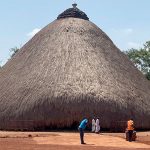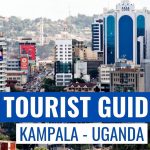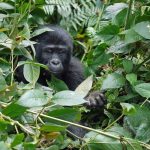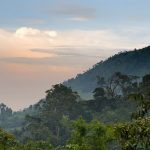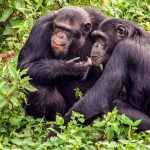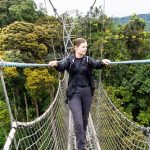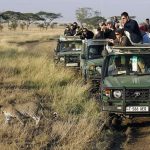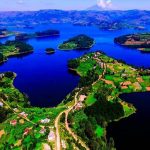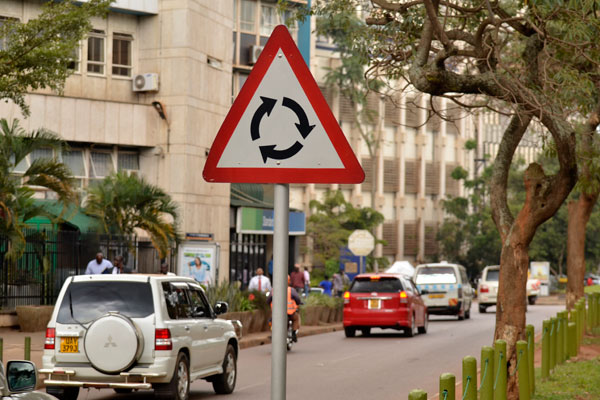Bwindi impenetrable national park is located in southwestern Uganda and it’s among the unique wildlife destination in Uganda. With the land area of 331 kilometer squares, a large portion of the national park is covered by a dense forest hence the name impenetrable forest national park. There are a number of wildlife species in Bwindi impenetrable forest that allure a number of adventurous tourists interested in exclusive wildlife safari experiences in east Africa and Uganda in particular.
Bwindi Impenetrable National Park is the most known of all national parks in Uganda. Home to almost half of the world’s population of the mountain gorillas, Bwindi is the best place to see the endangered mountain gorillas in Africa.
Park at a Glance
Size: 321km2
Altitude: 1,160m – 2,607m above sea level.
Bwindi was gazetted as a National Park in 1991 and later it was declared a UNESCO Natural World Heritage Site in 1994. The park was declared because it was the only home to three apes; the mountain gorillas, chimpanzees and the Batwa People. Today the Batwa People were evicted out of the forest so that the mountain gorillas can be better protected with minimal human interference on the ecosystem.
Bwindi Impenetrable National Park lies in southwestern Uganda on the edge of the Rift Valley. Its mist-covered hillsides are blanketed by one of Uganda’s oldest and most biologically diverse rain forests, which dates back over 25,000 years and contains almost 400 species of plants. More famously, this “impenetrable forest” also protects an estimated 320 mountain gorillas – roughly half of the world’s population, including several habituated groups, which can be tracked.
Things to See in Bwindi
Spread over a series of steep ridges and valleys, Bwindi Impenetrable Forest is the source of five major rivers, which flow into Lake Edward.
This biologically diverse region also provides shelter to a further 120 mammals, including several primate species such as baboons and chimpanzees, as well as elephants and antelopes. There are around 350 species of birds hosted in this forest, including 23 Albertine Rift endemics.
The neighboring towns of Buhoma and Nkuringo both have an impressive array of luxury lodges, rustic bandas and budget campsites, as well as restaurants, craft stalls and guiding services. Opportunities abound to discover the local Bakiga and Batwa Pygmy cultures through performances, workshops and village walks.
The major wildlife wonders one should not miss while in Bwindi include;
The Mountain Gorillas
They are endangered apes and the prime attractions in Bwindi impenetrable national park. Bwindi is a home to half of the remaining mountain gorillas on the planet with 11 habituated mountain gorilla families each family being trekked by a group of 8 tourists a day. The mountain gorillas live along the slopes of the misty forested mountains in Bwindi and trekking them offers exclusive wildlife safaris. On the day of trekking,tourists are expected to wake up in the morning and head to the park headquarters for a briefing in the morning together with their trekking gear, drinking water and packed lunch. After the briefing, they head to the forested mountains ascending to track the gorillas,an activity that takes 1-8 hours depending on the movement of the apes in their natural wild. After meeting and staying in the presence of the gorillas for a maximum of one hour, the tourists descend back to the national park headquarters where they are given certificates of participation. The mountain gorilla trekking experience can be best enjoyed during the dry season.
The Birds
There are over 300 bird species in the jungles of Bwindi including 24 species that are endemic to the Albertine rift. While in the forest, you cannot fails to see birds like the African broadbill, fowls, Turacos like the black-billed Turacos and many others. The national park is among the major birding destinations in Uganda and therefore going there for birding can never be a regrettable idea. A pair of binoculars for clear viewing is recommended.
Bwindi impenetrable forest is not only a habitant for mountain gorillas but also other wildlife species and its therefore a diverse ecosystem among the must visit wildlife destinations in Uganda.
The Local Culture
The local people around this national park are the Batwa pygmies who were initial forest dwellers but because of need for conservation were forced to move out of the forest. They have unique cultural practices and usually demonstrate their hunter-gatherer skills plus traditional dance performances for the tourists. The Batwa cultural experience is very exciting memorable as you discover the unique ways of life of one of the cultural group in Uganda.
Other wildlife species in Bwindi impenetrable national park include the thick and evergreen vegetation with different types of trees that stand several meters above the ground. There are also a number of butterflies and many other small insects and reptiles in Bwindi impenetrable forest.
Gorilla Trekking in Bwindi
There are several habituated gorilla groups that can be visited by tourists taking Uganda gorilla trekking safaris in the park. The Mubare gorilla group was the first to become available for tourism in Uganda in April 1993. Today there are 15 gorilla groups that have been habituated for tourism, and one for research.
There are four gorilla trekking centers;
- Buhoma the park headquarters has three gorilla families
- Rushaga has five gorilla families
- Ruhija has four gorilla families while Nkuringo has one gorilla family.
These eco-tourism sites offer a variety of guided hiking trails and walks to take you to its beautiful attractions. Discover beautiful waterfalls in Buhoma and fascinating plant life including orchids, giant tree ferns and flowers.
Known for its birds, about 346 in Bwindi Forest, 90% are Albertine rift endemics. Visitors with interest in bird watching, hike to Mubwindi swamp in Ruhija to spot the stripe breasted, African green broadbill tit or use the waterfall and river Ivi trail in Buhoma to see kivu ground thrush, short tailed warbler, Chapin’s flycatcher.
There are also local tourism enterprises and gorilla conservation projects around which educate visitors and also support community development including the BaTwa who were evicted from the forest in 1994. So after your gorilla trek, spare time and take a village walk. Visit the ancient BaTwa homestead. Learn about their traditional culture lifestyles through dance performances, food, hand-made crafts and the money they earn benefits women and children.
Getting There
Bwindi impenetrable national park is located in southwestern Uganda and getting there by road takes about 6 to 7 hours. The drive is very exciting as it takes tourists through the beautiful countryside of Uganda with scenic views of the gently sloping and terraced Kigezi highlands.
Alternatively, one can use air transport with charter planes from Entebbe international airport or Kajjansi airstrip to Kihihi or Kayonza airstrips ad then connect to the national park.
Best Time To Visit Bwindi
The national park can be best visited during the dry season because it’s when it’s easy to move through the forested mountains. The roads connecting to Bwindi are also very passable during the dry season.
What To Carry On Your Safari to Bwindi
A raincoat and a waterproof jacket is highly recommended because most times its hard to predict rain fall meaning It can happen at anytime of the year. Other essentials include good hiking shoes, a sweater, a pair of hand gloves and a camera to capture the great moments while in the forest.

